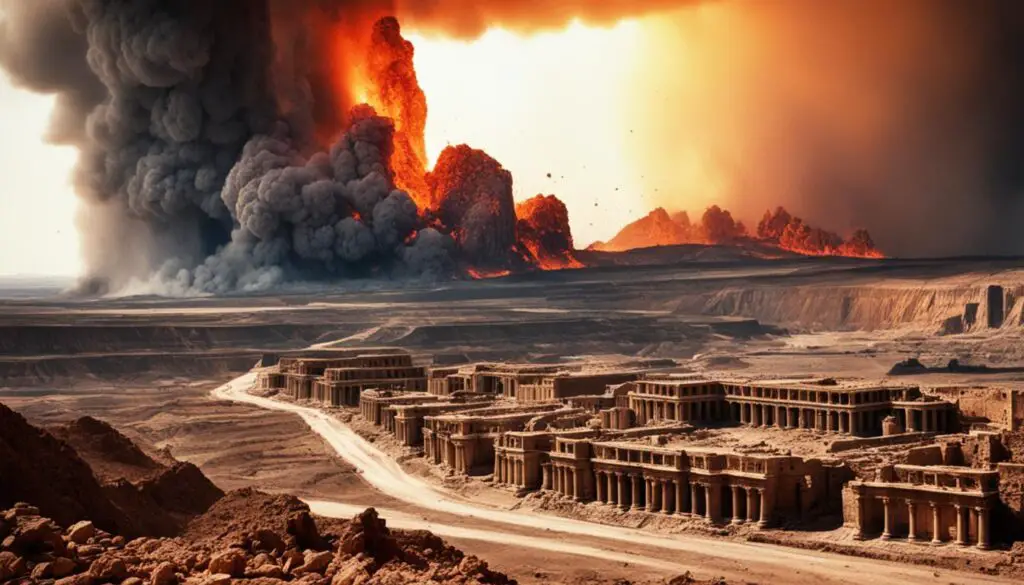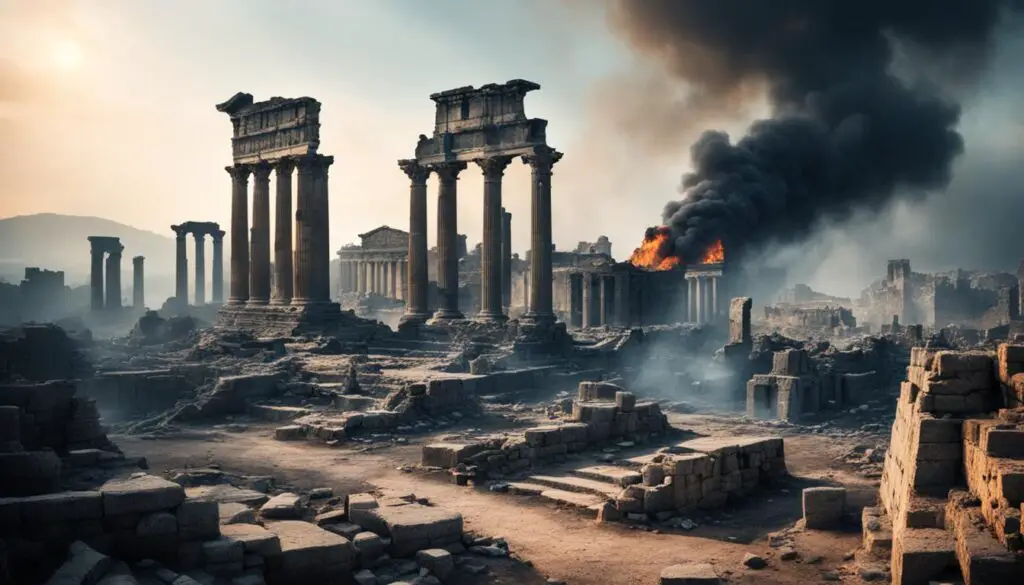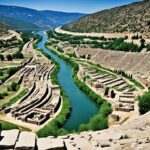Welcome to our exploration of one of the most intriguing stories in the Bible – the story of Sodom and Gomorrah. These ancient cities, mentioned in the Old Testament, have captivated the minds of believers and scholars alike for centuries. Join us as we delve into the biblical account, examine the archaeological evidence, and uncover the historical and theological significance of Sodom and Gomorrah.
Key Takeaways:
- The biblical account of Sodom and Gomorrah showcases the destruction of these cities due to their sinful behavior.
- Lot and his wife were central characters in the story, with Lot narrowly escaping the cities’ destruction.
- The cities of Sodom and Gomorrah were part of the region known as the Cities of the Plain.
- The story of Sodom and Gomorrah holds historical and theological significance, emphasizing divine judgment and the importance of righteousness.
- Archaeological discoveries have provided evidence supporting the existence and destruction of these biblical cities.
Historical Significance of Sodom and Gomorrah
Sodom and Gomorrah, ancient cities in biblical history, hold immense historical significance. According to the Bible, these cities were ravaged by sin and faced divine judgment. The story of Lot’s escape from these wicked cities serves as a cautionary tale and a testament to God’s justice.
“And the Lord said, ‘Because the outcry against Sodom and Gomorrah is great, and because their sin is very grave, I will go down now and see whether they have done altogether according to the outcry against it that has come to Me; and if not, I will know.'” – Genesis 18:20-21
The destruction of Sodom and Gomorrah is a poignant reminder of the consequences of sinful behavior. It serves as a historical and moral lesson, highlighting the importance of righteousness and obedience to God’s commandments.
The biblical account of Lot’s escape showcases the divine intervention and protection given to the righteous. It emphasizes the significance of making virtuous choices and seeking refuge from the corrupting influence of sinful cities.
The Sinful Cities of Sodom and Gomorrah
- The cities of Sodom and Gomorrah were infamous for their decadence and moral depravity.
- They were known for their widespread sexual immorality and illicit practices.
- Idolatry and disobedience to God’s commands were prevalent in these cities.
- The sins of Sodom and Gomorrah reached a point where they invoked divine judgment.
Sodom and Gomorrah serve as a reminder of God’s intolerance for unrepentant sin and the repercussions that follow. Their historical significance lies in the divine judgment they faced and the enduring moral lessons they convey.
The Story of Lot’s Escape
The story of Lot’s escape from Sodom showcases the mercy and protection of God. As the city faced imminent destruction, Lot and his family were warned to flee and not look back. This event highlights the importance of faith, obedience, and trust in divine guidance.
“Escape for your life! Do not look behind you nor stay anywhere in the plain. Escape to the mountains, lest you be destroyed.” – Genesis 19:17
Lot’s wife, however, disobeyed and looked back, resulting in her transformation into a pillar of salt. This serves as a warning against clinging to the sinful past and the need to fully commit to a righteous path.
The significance of Lot’s escape lies in its portrayal of God’s deliverance for the righteous and the consequences of straying from His commands. It serves as a timeless lesson of faith and the importance of choosing the path of righteousness.
Geographical Location of Sodom and Gomorrah
Sodom and Gomorrah, two of the five cities known as the Cities of the Plain, were situated in the vicinity of the Dead Sea. The exact location of these biblical cities has been a subject of debate among scholars and archaeologists.
Evidence suggests that Sodom and Gomorrah were situated either south or north of the Dead Sea. The region surrounding the Dead Sea, also known as the Salt Sea, is characterized by its unique geographical features and is renowned for its salt content and mineral-rich waters.
Located amidst the rugged landscape of the ancient Middle East, the Cities of the Plain held historical and religious significance. These cities, including Sodom and Gomorrah, were known for their sinful practices and were ultimately destroyed as a result.
While the debate about the exact location of Sodom and Gomorrah continues, the Dead Sea vicinity remains a fascinating region of exploration for historians, archaeologists, and enthusiasts alike.

The Cities of the Plain: Geographical Significance
The geographical location of Sodom and Gomorrah in the Dead Sea vicinity offers valuable insights into the biblical narrative and allows us to better understand the context in which these cities existed.
The Dead Sea is a landlocked salt lake bordered by Jordan to the east and Israel and Palestine to the west. It is situated at the lowest elevation on Earth and is known for its high salinity, making it a unique natural wonder.
| Geographical Features | Location |
|---|---|
| Dead Sea | Between Jordan, Israel, and Palestine |
| Biblical Cities | Located in the vicinity of the Dead Sea |
| Rugged Landscape | Around the ancient Middle East |
The geographical location of Sodom and Gomorrah in the Dead Sea vicinity is significant in understanding the historical, cultural, and religious context of these cities. The surrounding region influenced the lifestyle and practices of the people who inhabited the Cities of the Plain.
Continued research and exploration in this region may provide further insights into the exact locations of Sodom and Gomorrah, shedding light on an ancient civilization destroyed millennia ago.
Archaeological Discoveries of Sodom and Gomorrah
In 1973, excavations in the area southeast of the Dead Sea led to the discovery of two significant archaeological sites – Bab edh-Dhra and Numeira. These sites have been extensively studied and are believed to be closely associated with the biblical cities of Sodom and Gomorrah. The discoveries made during these excavations provide valuable insights into the ancient civilization that once thrived in this region.
The archaeological finds at Bab edh-Dhra and Numeira include ancient structures, cemeteries, and artifacts, all of which have shed light on the history and culture of the cities. Excavations have revealed evidence of well-planned urban settlements, pottery workshops, and trade connections with neighboring regions. The artifacts discovered, such as pottery vessels, jewelry, and weapons, offer valuable clues about the daily life, craftsmanship, and social structure of the inhabitants of Sodom and Gomorrah.
The excavations have also uncovered evidence of catastrophic destruction, possibly caused by natural disasters or violent conflicts. This aligns with the biblical account of the destruction of Sodom and Gomorrah, described in Genesis 19. The archaeological findings provide a glimpse into the events that unfolded thousands of years ago and lend further credibility to the existence of these notorious cities.
The Archaeological Discoveries of Bab edh-Dhra and Numeira
The excavations at Bab edh-Dhra and Numeira have offered remarkable insights into the ancient civilization that once thrived in the region believed to be the location of Sodom and Gomorrah. Here are some of the notable discoveries:
| Archaeological Discoveries | Description |
|---|---|
| Ancient Structures | Evidence of well-planned urban settlements with residential buildings, public buildings, and fortifications. |
| Cemeteries | Excavations have revealed burial sites, providing insights into burial practices and cultural beliefs. |
| Artifacts | Various artifacts, including pottery vessels, jewelry, weapons, and tools, have been discovered, giving valuable information about the daily life and craftsmanship of the ancient inhabitants. |
| Catastrophic Destruction | Significant evidence of destruction, possibly resulting from natural disasters or conflicts, supporting the biblical account of the cities’ downfall. |
The archaeological discoveries at Bab edh-Dhra and Numeira have deepened our understanding of the historical and cultural significance of Sodom and Gomorrah. These findings reinforce the notion that these ancient cities were not mere mythological constructs but thriving settlements that met a catastrophic end.
Excavations in the area surrounding the Dead Sea have revealed valuable insights into the history and culture of the biblical cities of Sodom and Gomorrah. The discoveries made at sites like Bab edh-Dhra and Numeira provide tangible evidence of the existence of these cities and shed light on their intriguing past. Through careful archaeological analysis, we can piece together a clearer picture of the civilization that once inhabited this ancient region.
Theological Themes in the Story of Sodom and Gomorrah
The story of Sodom and Gomorrah carries important theological themes within the biblical narrative. It portrays God’s wrath and divine judgment upon cities consumed by sin and wickedness. The narrative also emphasizes the significance of hospitality, as Lot’s righteous acts demonstrate the importance of extending kindness and generosity towards others.
“And the Lord said, ‘Because the outcry against Sodom and Gomorrah is great, and because their sin is very grave, I will go down now and see whether they have done altogether according to the outcry against it that has come to Me; and if not, I will know.'”
The story of Sodom and Gomorrah highlights the consequences of sin and the concept of divine judgment. The cities’ wickedness and depravity reached such a level that God decided to destroy them. This serves as a reminder that sin does not go unnoticed and that God’s justice will ultimately prevail.
Furthermore, the importance of hospitality is exemplified in the story. When two angels disguised as travelers visited Sodom, Lot extended his hospitality by offering them shelter and protection. Lot’s actions demonstrate the value of welcoming strangers and showing kindness, even in the face of a sinful environment.

The story of Sodom and Gomorrah continues to resonate with believers, as it raises important theological questions about divine judgment, God’s wrath, sin and punishment, and the role of hospitality in our lives. It serves as a reminder to lead a righteous life, show kindness to others, and turn away from sinful behavior.
| Theological Themes | Description |
|---|---|
| Divine Judgment | Portrayal of God’s wrath and judgment upon sinful cities. |
| God’s Wrath | Illustration of God’s anger towards unrepentant sin and wickedness. |
| Sin and Punishment | Consequences of sinful behavior and the need for repentance. |
| Hospitality | Importance of extending kindness and generosity towards others. |
Key Biblical Events in Sodom and Gomorrah
Several key events unfold in the biblical account of Sodom and Gomorrah. These events are crucial to the overall narrative and provide insight into the moral lessons conveyed in the story.
- Lot’s Hospitality Towards Angels: When two angels visited Sodom, Lot, who was residing in the city, extended his hospitality by offering them a place to stay for the night. This act of kindness highlights Lot’s righteousness and his willingness to protect the strangers.
- Attempted Assault on the Angels: The men of Sodom, both young and old, approached Lot’s house and demanded that the angels be handed over to them for sexual purposes. This shocking display of wickedness and depravity illustrates the moral decay that had consumed the city.
- Warning of Impending Destruction: The angels revealed to Lot that God had planned to destroy Sodom and Gomorrah due to their grievous sins. This warning served as an opportunity for Lot and his family to escape the imminent catastrophe.
- Lot’s Escape: As dawn approached, the angels urged Lot and his family to flee the city and not look back. Lot, his wife, and their two daughters fled towards the nearby town of Zoar. However, Lot’s wife disobeyed the command and looked back, resulting in her transformation into a pillar of salt.

These events in Sodom and Gomorrah serve as a cautionary tale, illustrating the consequences of moral corruption and the importance of righteousness. They demonstrate the significance of extending hospitality and the destructive power of sin. The narrative of Sodom and Gomorrah continues to be an enduring part of biblical history and offers timeless lessons for readers today.
Cultural and Religious Practices in Sodom and Gomorrah
The biblical account portrays Sodom and Gomorrah as cities characterized by wickedness, depravity, and cultural and religious practices that defied God’s commandments. These cities were infamous for their sexual immorality and idolatry, which ultimately led to their devastating downfall.
The inhabitants of Sodom and Gomorrah indulged in wicked acts, embracing a lifestyle characterized by sin and moral decay. Sexual immorality was prevalent, with the cities notorious for their depraved practices. The people disregarded the sanctity of marriage and engaged in various forms of sexual misconduct, deviating from the divine order.
In addition to sexual immorality, idolatry was rampant in Sodom and Gomorrah. The residents of these cities worshipped false gods, straying from the worship of the one true God. Their idolatrous practices were a rejection of God’s commandments and an affront to His authority.
“And the Lord said, ‘Because the outcry against Sodom and Gomorrah is great, and because their sin is very grave, I will go down now and see whether they have done altogether according to the outcry against it that has come to Me; and if not, I will know.'” – Genesis 18:20-21
The cultural and religious practices in Sodom and Gomorrah were a clear manifestation of the cities’ wickedness and depravity. These sinful behaviors ultimately brought about their destruction as divine judgment fell upon them.

Key Points:
- Sodom and Gomorrah were characterized by wickedness, depravity, and disobedience to God’s commandments.
- Sexual immorality was prevalent in these cities, with the inhabitants engaging in immoral practices.
- Idolatry was also widespread, as the people worshipped false gods.
- The cultural and religious practices in Sodom and Gomorrah ultimately led to their destruction as divine judgment.
Prophetic and Eschatological Significance of Sodom and Gomorrah
The story of Sodom and Gomorrah carries great prophetic and eschatological significance in the Bible. The destruction of these cities serves as a powerful warning to future generations, highlighting the consequences that await those who persist in unrepentant sin. The narrative of Sodom and Gomorrah foreshadows future events and offers valuable lessons for humanity.
Divine Judgement as a Warning
The destruction of Sodom and Gomorrah stands as a testament to God’s judgement upon societies that embrace wickedness and immorality. It serves as a warning to humanity about the consequences of turning away from righteousness and disregarding God’s commands. This dramatic event reminds us of the importance of living an upright and virtuous life.
Foreshadowing of Future Events
The story of Sodom and Gomorrah provides a glimpse into future events that will culminate in the eschatological judgement. It serves as a reminder that God will ultimately hold everyone accountable for their actions. Just as the cities met their fiery demise, there will come a time when all will face the consequences of their choices.
Lessons for Humanity
The account of Sodom and Gomorrah offers valuable lessons for humanity. It teaches us the significance of living according to God’s principles and commands. It warns against the pursuit of sinful desires, highlighting the destructive path it leads to. The story serves as a call to repentance and righteousness, urging us to seek a life that aligns with God’s will.
“Take heed of the fate of Sodom and Gomorrah. Their wickedness led to their destruction. Learn from their example and choose righteousness.”
Understanding the prophetic and eschatological significance of Sodom and Gomorrah enables us to grasp the magnitude of God’s judgement and the importance of aligning our lives with His righteous standards. May the lessons from this biblical account guide us towards a life of righteousness and obedience.
Controversies and Debates Surrounding Sodom and Gomorrah
The discovery and interpretation of Sodom and Gomorrah have ignited intense controversies and sparked thought-provoking debates among scholars and theologians. These discussions primarily revolve around the historicity of the cities, alternative interpretations of the biblical account, and the symbolic representation of the events.
One of the key areas of controversy is the historicity of Sodom and Gomorrah. While some scholars argue for the existence of these cities based on archaeological findings and geographical evidence, others question the validity of their historicity. Skeptics propose that the story may be allegorical or symbolic rather than an actual account of events that transpired in ancient times.
“The story of Sodom and Gomorrah may not be a historical narrative but a symbolic representation of moral lessons, serving as a cautionary tale against wickedness and its consequences.”
Alternative interpretations of the biblical account also add to the controversies surrounding Sodom and Gomorrah. Different scholars and theologians offer diverse perspectives on the sins committed by these cities and the nature of their destruction. Some focus on the prevalent sexual immorality and depravity, while others highlight idolatry and social injustice as the primary reasons for their demise.
The symbolic representation of Sodom and Gomorrah is another subject of debate. Many view the story as carrying deeper meaning, representing the ongoing struggle between good and evil, divine judgment on wickedness, or the consequences of disobedience. This symbolic interpretation emphasizes the allegorical nature of the narrative and the moral teachings it conveys.
Overall, the controversies surrounding Sodom and Gomorrah demonstrate the multifaceted nature of biblical stories and the diverse ways in which they can be understood and interpreted. These debates further enrich the exploration of ancient texts and offer fertile ground for the examination of historical, religious, and philosophical perspectives.

Interpretations of Sodom and Gomorrah
| Interpretation | Description |
|---|---|
| Literal Historical Event | The cities of Sodom and Gomorrah actually existed, and their destruction was a real event. |
| Symbolic Allegory | The story represents moral lessons and carries symbolic meaning rather than describing literal historical events. |
| Punishment for Specific Sins | The cities were destroyed as a result of specific sins such as sexual immorality, social injustice, or idolatry. |
| Divine Judgment on Wickedness | The narrative portrays God’s judgment on wickedness and serves as a warning against sinful behavior. |
Conclusion
The story of Sodom and Gomorrah holds a unique place in the biblical narrative, serving as a powerful illustration of divine judgment and the dire consequences of sinful behavior. The historical and theological significance of these cities and their ultimate destruction carry profound lessons for humanity, emphasizing the importance of righteous living and obedience to God’s commandments.
The archaeological evidence surrounding Sodom and Gomorrah provides further confirmation of the accuracy of the biblical account, as excavations in the region have unearthed ancient structures, cemeteries, and artifacts that offer insights into the civilizations that once thrived in this area. This tangible evidence adds a historical dimension to the biblical narrative, enriching our understanding of the events described in the Old Testament.
By studying the story of Sodom and Gomorrah, we learn valuable lessons about the consequences of unrepentant sin and the need for righteousness. It reminds us of the importance of living in accordance with God’s commands and highlights the dangers of indulging in wickedness and immorality. The narrative serves as a powerful reminder that divine judgment awaits those who persist in sinful behavior.
In conclusion, the story of Sodom and Gomorrah has both historical and theological significance, offering profound lessons about righteous living and the consequences of disobedience. The archaeological discoveries in the region further validate the biblical narrative and provide glimpses into the ancient civilizations that once inhabited this area. The tale of Sodom and Gomorrah continues to resonate with believers and scholars alike, reminding us of the enduring lessons to be found within the pages of the Bible.
FAQ
What is the story of Sodom and Gomorrah in the Bible?
Where were Sodom and Gomorrah located?
Are there any archaeological discoveries related to Sodom and Gomorrah?
What theological themes are present in the story of Sodom and Gomorrah?
What were some key events in the biblical account of Sodom and Gomorrah?
What were the cultural and religious practices in Sodom and Gomorrah?
What is the prophetic and eschatological significance of Sodom and Gomorrah?
Are there any controversies surrounding Sodom and Gomorrah?
What is the conclusion of the story of Sodom and Gomorrah?
Source Links
- https://www.smithsonianmag.com/smart-news/destruction-of-city-by-space-rock-may-have-inspired-biblical-story-of-sodom-180978734/
- https://www.simonandschuster.com/books/Discovering-the-City-of-Sodom/Steven-Collins/9781451684384
- https://biblearchaeology.org/research/patriarchal-era/2364-the-discovery-of-the-sin-cities-of-sodom-and-gomorrah







